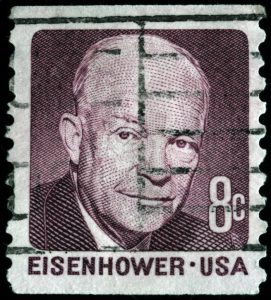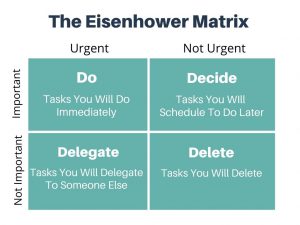Dwight D. “Ike” Eisenhower got stuff done. He was a five-star general in World War II, the 34th President of the United States, the president of Columbia University, and the first Supreme Commander of NATO. During his two terms as U.S. President, he got NASA off the ground, began construction on the Interstate Highway System, signed a major piece of Civil Rights legislation into law, ended the Korean War, AND oversaw the introduction of two new states into the Union (Alaska and Hawaii).
Not bad, Ike, not bad. So what was his secret? Well, you can actually boil it down to the difference between two words that often come up in our work life, words which might seem very similar: “urgent” and “important.” This distinction can make the difference between being simply efficient or busy, and being effective in your business life. And all it takes is organizing your tasks into four different categories, using a method known as The Eisenhower Matrix, and you could be one step closer to reaching your goals, and keeping your business growing!
Do You Need a Way to Prioritize?

Before we get into the nuts and bolts of the Eisenhower Matrix, let’s take a quick quiz. Answer honestly! As a small business owner:
- Do you feel like you’re constantly putting out fires? In other words, are you running around all day making sure those little “emergencies” are tended to – and then before you know it, your day is done?
- Would you describe yourself as “very busy,” but, at the same time, do you have a hard time pointing to the impact that your work is having in the long run?
- Are you having a hard time delegating tasks?
- Do you have clear long-term goals for your business laid out, but you just can’t find the time (or the energy) to work towards them?
- When you’re looking at things that need to get done, do you find yourself gravitating towards the tasks that are more time-sensitive as opposed to those that would have a long-term reward?
If you answered “yes” to some or all of these questions, prioritization might be a big problem that’s holding you (and your business) back. And you’re not alone! In fact, a recent study in the Journal of Consumer Research found that people are much more likely to give their attention to time-sensitive tasks over tasks that are less urgent even when the less urgent task offers greater rewards, a phenomenon they call the “Mere-Urgency Effect.”
You need to break out of this mindset, and become less “busy” and more focused on what’s really important. Being efficient is great, and checking off your to-do list can feel good in the moment (annoying as the tasks might be), but sometimes you’ve just got to ask yourself: “Do I actually need to be doing this?” It is arguably a harsh point of view, but entrepreneur Tim Ferriss even went so far as to say, “Being busy is a form of laziness – lazy thinking and indiscriminate action.” Even if you don’t agree, you can still use the Eisenhower Matrix to figure out what to “delete” from your day.
The History of the Eisenhower Matrix

Eisenhower, productive as he was, knew that reaching your goals isn’t just about getting stuff done; after all, you can check off everything on a daily to-do list and still not be any closer to a big life goal. To really make a difference (whether it’s in the political world or the business world), you have to stop wasting time and prioritize tasks more effectively, so you can focus on what’s most important.
And the first step to focusing on what’s important, according to the former president, is understanding the difference between urgency and importance, because they are not the same thing: Eisenhower even famously quoted a university president who said, “I have two kinds of problems, the urgent and the important. The urgent are not important, and the important are never urgent.” But he knew that we are all very easily sidetracked by the urgent: as he said in a 1954 address, “Especially whenever our affairs seem to be in crisis, we are almost compelled to give our first attention to the urgent present rather than to the important future.”
So, to try to rebalance his attention, Eisenhower created a method for making tough decisions about which of the many tasks he should focus on each day. This method is now called the Eisenhower Matrix (or the Time Management Matrix, the Eisenhower Box, the Eisenhower Method, or the Urgent-Important Matrix). Using this method of time management and prioritization will help you to focus on tasks that are actually important in the long run.
The Urgent Vs. The Important
The Eisenhower Matrix is actually fairly simple in theory. This method of prioritization just requires you to place tasks into four quadrants, which will determine how urgent they are versus how important they are. Making that determination can seem a little tricky sometimes, we know, but try following Steven Covey’s, author of The 7 Habits of Highly Effective People, definitions of the two terms:
- Urgent: These are tasks that “require immediate action.” There are often consequences to not completing them on time or as they pop up. Getting too stuck on urgent, “putting out fires”-type of tasks can sap your energy and lead to burnout.
- Important: Things that are important “contribute to long-term goals and life values.” They require “planning and thoughtful action,” as opposed to being mindless like urgent tasks can sometimes be. These tasks also actually tend to focus you, instead of keeping you feeling scattered and pulled in different directions.
Step into the Matrix
Now that we’ve made those distinctions, let’s get to making the matrix. As we said earlier, you’ll need to separate your activities into four quadrants, which represent priority levels:
- Urgent and Important
- Not Urgent and Important
- Urgent and Unimportant
- Not Urgent and Unimportant
You can make your own Matrix (or download a template): draw a square and divide it into four squares; starting with the top left quadrant and moving clockwise, create four categories:
- Do – In this box will be your urgent/important tasks. These things generally need to be done immediately and include things you would classify as crises, deadlines and any urgent problems that come up. They require a lot of energy and attention, and might have some dread factor to them, so get them done first. If you’re having trouble getting through these tasks, try using the Pomodoro Technique to keep you focused.
- Decide – Next to your “do” tasks will be your not urgent/important tasks. These are known as your “decide” tasks because you have more leisure to decide when they should be completed, although that doesn’t mean you shouldn’t set a realistic timeline to complete them. You can also think of this space as the quadrant for your longer-term goals, so this area should definitely be your top priority, especially since these are the tasks that leave you feeling fulfilled, instead of burnt out.
As you become more efficient at managing your time, and are better able to delete unimportant things and plan for the urgent tasks that come up, hopefully most of your tasks will end up here! In fact, if you’re using this method, you want to try and rebalance your time so that you’re spending most of it in this quadrant, which Steven Covey calls “the quadrant of quality.” Time spent on these tasks will increase your overall effectiveness, because you’ll be working toward personal and professional growth.
- Delegate – Underneath your “do” quadrant is your “delegate” quadrant, reserved for the tasks that are urgent/unimportant. These tasks are usually more important to other people than to you, but they’re still pretty urgent, and need to get done. So you know what? This is where good old fashioned teamwork comes into play! If you have employees, acknowledge that one of them might be better suited to the task, and thus free yourself up for using more of your time and energy on your “decide” tasks. Just remember to keep track of delegated tasks, and if you don’t have a lot of extra manpower, consider outsourcing some of these things.
- Delete – Ah, now we’ve come to the not urgent/unimportant tasks – you know, the things that should be on your “not-to-do” list. This can include avoidance tasks, such as sorting and organizing your email instead of answering it, or even downtime activities that drain your energy and creativity instead of enhancing it (think scrolling endlessly as opposed to exercising, reading or volunteering). If you find yourself stuck in this quadrant, you might be stressed, stuck in a rut, or avoiding a problem, so try to steer yourself back to your “decide” quadrant and rediscover your passion!
If you’re looking for a useful decision-making tool to boost your productivity and effectiveness as the leader of a small business, the Eisenhower Matrix could work to keep you balanced and focused. Give it a try! At the very least, you might find yourself eliminating behaviors that take up your time, your mental energy, and don’t move you any closer to your goals.